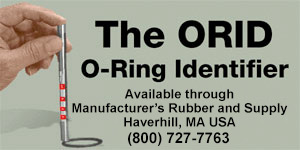 The ORID® 70-C will indicate the material composition of 100, 200, 300 and 400 series O-Rings of 60 to 80 Durometer which are already known to be either Viton®, Kalrez®, Nitrile or EPDM.
The ORID® 70-C will indicate the material composition of 100, 200, 300 and 400 series O-Rings of 60 to 80 Durometer which are already known to be either Viton®, Kalrez®, Nitrile or EPDM.
The O-Rings must be within their rated shelf life and be unused and undamaged to complete the O-ring identification process.
How The ORID® Works:
The ORID itself is a tube with a controlled or specific weight inside it. The weight falls a controlled distance. To determine an O-ring’s rubber compound:
- Place the o-ring on a stable table or surface
- Place the ORID® over the O-ring and raise the weight all the way to the top of the tube (as far as it will go)
- Release the weight and let it drop onto the o-ring. It will bounce.
- The height of the first bounce will rise to one of the four calibrated ranges. The highest is EP (Ethylene Propylene). The next is Nitrile. The next is Kalrez®. The lowest graduation is Viton®. This indicates your rubber compound.
Labeled Graduations
The height of the FIRST bounce indicates the O-Ring:
- Highest Graduation — EP ethylene propylene O-Rings are compatible with most water-based chemicals from 70 º F to +300 º F.
- Third Graduation — NITRILE. Also, known as Buna-N. These O-Rings are good for most plumbing applications from -30 º F to +225 º F.
- Second Graduation — KALREZ®. Also known as perfluorocarbon, compatible with most aggressive chemicals from 0 º F to +600 º F.
- Lowest Graduation — VITON®. This composition is also called fluorocarbon. Viton O-Rings are generally compatible with most petroleum-based liquids from -15 º to +400 º F.
The results obtained through the use of this device have been consistent and repeatable in our evaluations. However, since a degree of user technique is required we cannot be responsible for specific results. For questions or more information, contact our team.

